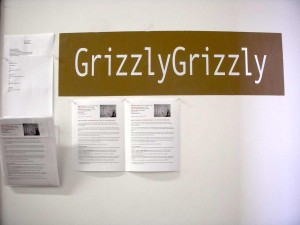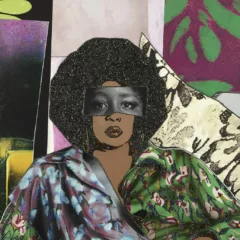Cate and I went to the Vox building the Saturday after First Friday (which is usually a great day to go — mostly, the audio-video-robo works will be functioning; and often artists are lurking who will talk with you about what they’re up to). We found a bunch of good stuff at Tiger Strikes Asteroid, Napoleon and Vox Populi.
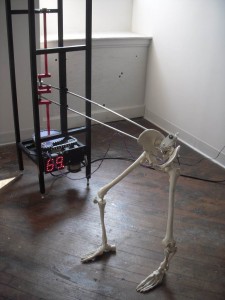
moving on is a spare little show. With works by three artists, one local, one in London and one in upstate New York, the exhibit covers a lot of geography — and a lot about the human condition, in sexy, manic, or bare-bones fashion.
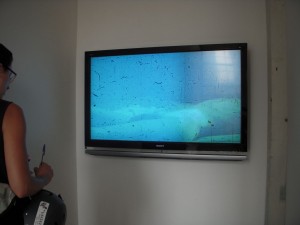
The surprise here is Carolee Schneemann, the powerhouse 60’s-era feminist artist — her presence is highly unexpected in an alternative gallery show. “Fuses,” her scratchy film-to-video, (1966) is a melange of moving images of bodies (herself and her boyfriend making love), sometimes so up-close they are completely abstract. The work slips from one image to another with a liquid fluidity, and the mournful piece talks beautifully with both Tim Belknap’s skeleton piece and William Blackhurst’s two videos. All the work in the show is moody, a little forlorn and human-focused.
Belknap’s motorized skeleton somehow conjures the ambiance of a post-life The Dude with his loose-limbed, sandal-footed amble. Alexis Granwell, who was gallery sitting, said that the piece had been and was supposed to step more lively. But to me, the slow, almost-drunken movement more closely suggests the elasticity of time and its unstoppability. The digital read-out reinforces the idea of time and speed as well. Belknap has a solo show at Rebekah Templeton, and Dennis will tell you about that soon.
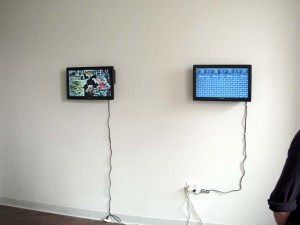
William Blackhurst’s animations merge video footage of what might be home movies with animation to create a psychedelic and fractured narrative — a take on human interaction that suggests we all have real and unreal characters within. The artist lives in London and the press release says this is his first gallery exhibit.
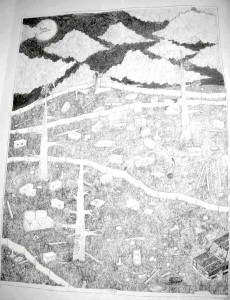
The tiny gallery looks great with a big group show in it! Commonplacing is the debut curating show by members of Napoleon; the members each selected one of the eleven artists in the show. Pay attention in particular to the wall drawing by Max Seckel, a marvel of control over a difficult surface (stucco). Described by Leslie Friedman — there when Cate and I visited — as a landscape with a Where’s Waldo aspect, the cartoon landscape is dotted with tiny references from the artist’s life. Seckel is a Space 1026 member.
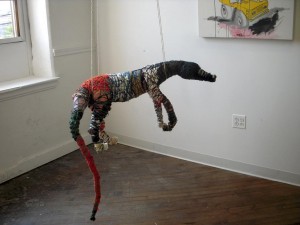
Perhaps because it is a large hanging object, Loo Bain’s “Fixed Strays” made of yarn, thread and string, has a big presence in the show. Backlit by the window and swaying in the breeze, it’s the piece you gravitate to first in the show. The colors are totally upbeat, but the hanging animal harkens back to the dark work of Berlinde De Bruyckere (featured in ICA’s Springtide show in 2005) who also suspends animals or animal-like creatures in the air (or on plinths) to suggest commodification. (See also, Maurizio Cattelan’s suspended horse.) I’m not sure that’s what’s on Bain’s mind (commodification) but it’s a reference for sure. Apparently the artist was going to use this structure an an armature for another piece but decided the armature is the finished work.
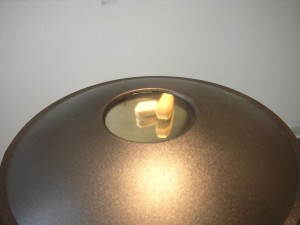
Edward Marshall Shenk’s mystery pills on a plinth are optical magic (due to an optical illusion). (Remind me somebody where I’ve seen this piece before…)
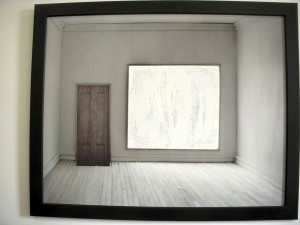
Also a kind of magic, Dana McElroy’s photo of a room with a spooky luminescent window, and a door that appears to be coming up out of the floor. We were told the image is of a miniature environment. Whatever the source, there’s some Magritte-like wizardry in the work.
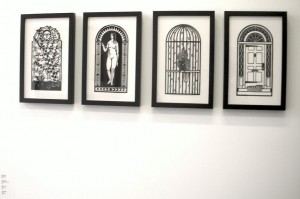
And it’s great to see Joe Boruchow’s cut paper works here. The virtuoso pieces are the basis for some of the artist’s recent street posters–you’ve seen them on mail boxes and elsewhere around town. Also in the show Shelby Donnelly, Hannah Rose Dumes Nelson Figueroa, Anna Gray, Ryan Wilson Paulsen and Ryan Parker.
Napoleon has a website now, designed by Matt Kalasky. The full complement of Napoleon members includes: Matthew Brett, Daryl Bergman, Dustin Campbell, Leslie Friedman, Christopher Hartshorne, Jose Ortiz, Jordan Rockford, H. John Thompson, Tamsen Wojtanowski and Jacob Yeager.
VOX POPULI
Vox members James Johnson and Anita Allyn create dueling environments that are oblique comments on human behavior.
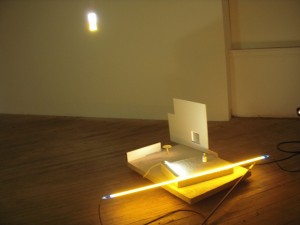
Johnson’s work is called Work and to read the press release it’s really about work — the work of the artist and what it means to be an artist. But honestly, when I saw Work I hadn’t read the release and so I didn’t think one thought about artists — I though about people. And I think Johnson’s piece is applicable to more than just the idea of the artist today, although artists are included of course.
Johnson has been a maker of theatrical environments for a while now. Usually, the stage-set-like rooms are accessible only through peep holes or windows. But this time the artist has abjured the container to display a few tiny scenes on the floor without their housing units to protect and encase them. There’s a tiny window in one wall (in front of an actual window, and this doll-house sized window lets in a jewel-like burst of light. Other lighting elements in the otherwise dark room ratchet up the theatricality.
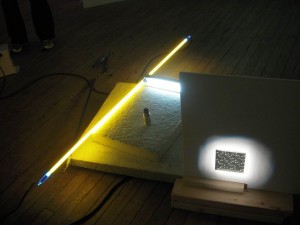
Like with an installation by Pepon Osorio or Ilya Kabakov, there is a story suggested, although Johnson is more a formalist and less a linear story-teller, and so the rudimentary installations (a table, a carpet, a light) suggest Waiting for Godot more than bodice-ripping page-turners. As you tower over the little environments, it’s hard not to feel your size and clumsiness — and how you are the outsider, the audience. No matter what your narrative here, the rooms are haunted, provoking thoughts about childhood hopes and expectations — with sadness, regret and anger all present.
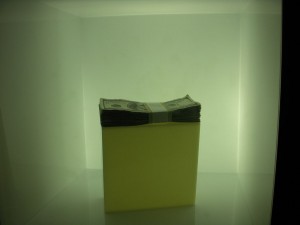
There’s one life size element — a really great-looking object — a box inset in the wall holding what appears to be a stack of large denomination bills. The glass-enclosed case is lit up like a jewel display in Tiffany’s. Everyone’s holy grail is money, whether you’re an artist or work on Wall St or at MacDonalds.
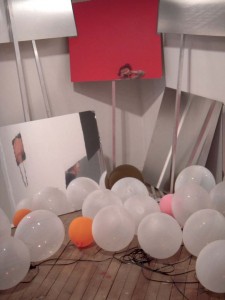
In the bright-lit gallery up front, Anita Allyn’s life-size installation, i heart postdemocracy, with balloons, reflective mylar-coated protest placards, mirrors and a low table, is another stage set. Allyn’s pre- or post-party installation (and the ironic title of her show) suggest the played-out actions of those who feel for/against a cause, policy, war, group, politician, but whose feelings are less articulable than the trappings of the protest. Hardly a call to arms, the work seems more a comment on and perhaps condemnation of civic engagement.
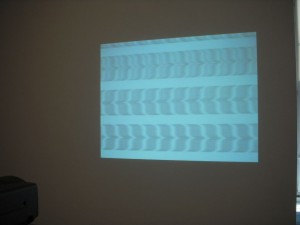
Guest artist Bonnie Begusch’s Motion Pictures — animated bits of moving type flying and flashing and flitting across screens or projected onto walls — reminds me of Young-Hae Chang Heavy Industries‘ moveable type text-video in the Temple Gallery Philagrafika show. Whereas the Heavy Industries’ piece is a story with music, Begusch’s silent works are abstractions of language — formalist designs using bits and pieces of keyboard type. Some of the pieces are more captivating than others — the piece projected low on the wall that has actual words — but words that are so blurry and sped up you can’t read them — kept us hostage as we hoped for a sentence, or at least a word or two (not forthcoming while we were there).
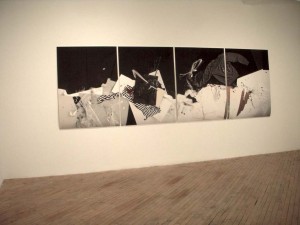
And guest artist Claudia Weber’s Something Something Panorama, a multi-panel photographic panorama, while formalist and chilly (it seems to show debris on a table or floor, has a cosmic night of the soul aspect that’s worth staring at for a bit (where’s the bench???!).
MARGINAL UTILITY AND GRIZZLY GRIZZLY
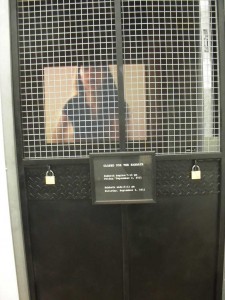
We walked up to Marginal Utility and were stopped by the gated and grated entrance to the gallery. The sign said they were closed for the Sabbath. According to MU’s David Dempewolf and Yuka Yokayama, this Sabbath closure is the wish of the artist Hadassa Goldvicht, a Brooklyn-based Israeli artist whose work is about ritual and voices and whose installation here is called Songs for the Peacemaker. In the dark gallery space, visible behind the grate is a video projection of a woman speaking, and this image behind the grated door conjures lots of ideas about prison, war, police states, harsh economic conditions even. The artist was in Italy at the time of the opening but would be back later in the month to install some additional work. Dempewolf met the artist at Skowhegan, he said. And another artist named David, David Carrow, created the door specially for the exhibit. David Carrow is a poet in metal and the door, while forbidding, is elegant and beautiful.
Grizzly Grizzly closes at 3pm on Saturday, something I always forget, so I am always there too late. But I enjoyed their new fancy gallery name printed on the wall. They’ve seriously claimed ownership now. Chip will tell you about the exhibit soon.


